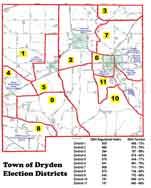Barack Obama
This morning Washington Journal referred to the Time cover article on Barack Obama and asked "Should Obama run for president in 2008?" Most people calling in said they didn't know enough about him even to have an opinion on whether or not he should run - several people even slamming the media for making a big deal about Obama when nobody's heard of him. I have to wonder why someone would call in to a talk show just to say how completely ignorant they are. But let's set that aside for a moment.
You've already heard me making a big deal about Obama and slamming the media for ignoring him. So as you can imagine, I'm please with the recent flood of coverage following the release of his book, The Audacity of Hope. If you know people who need some help getting to know Obama, try Americans For Democratic Action. Their 2005 scorecard evaluates voting records on twenty issues important to Democrats last year. Obama, along with twenty one other senators including Clinton and Schumer, voted for Democratic values on all these issues. The League of Conservation Voters ranks Obama 100% on seven key votes in 2006. The National Education Association gives Obama an A on 14 key votes in 2005 and 2006. Obama's Senate website and his professional website both include links to many of his speeches (but not the Iowa speech that so impressed me.)
Should Obama run for president? That's really not the most important question. Just listen to him. If you can't remember what the Democratic Party is about, if you have trouble explaining the Democratic Party to your relatives around the Thanksgiving table, if you're tired of hearing "Democrats don't have a plan," listen to Obama and follow the link on his website to Do More Than Vote.
You've already heard me making a big deal about Obama and slamming the media for ignoring him. So as you can imagine, I'm please with the recent flood of coverage following the release of his book, The Audacity of Hope. If you know people who need some help getting to know Obama, try Americans For Democratic Action. Their 2005 scorecard evaluates voting records on twenty issues important to Democrats last year. Obama, along with twenty one other senators including Clinton and Schumer, voted for Democratic values on all these issues. The League of Conservation Voters ranks Obama 100% on seven key votes in 2006. The National Education Association gives Obama an A on 14 key votes in 2005 and 2006. Obama's Senate website and his professional website both include links to many of his speeches (but not the Iowa speech that so impressed me.)
Should Obama run for president? That's really not the most important question. Just listen to him. If you can't remember what the Democratic Party is about, if you have trouble explaining the Democratic Party to your relatives around the Thanksgiving table, if you're tired of hearing "Democrats don't have a plan," listen to Obama and follow the link on his website to Do More Than Vote.


